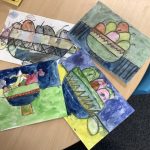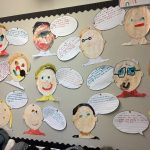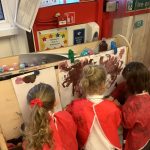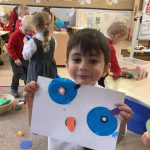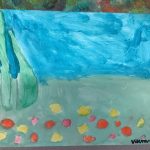Rationale
At Millbrook Primary School, we believe that Art contribute to the development of the whole child emotionally, aesthetically, physically, socially and cognitively. It provides all children with the opportunity to express themselves imaginatively, creatively and therefore developing their understanding of, and response to, the world around them.
Through our art opportunities in school, we aim to address the challenge and creativity aspects of our school by providing opportunities for children to explore their ideas and record their experiences through a variety of techniques using a variety of media too.
“Art, craft and design embody some of the highest forms of human creativity. A high-quality art and design education should engage, inspire and challenge pupils, equipping them with the knowledge and skills to experiment, invent and create their own works of art, craft and design. As pupils progress, they should be able to think critically and develop a more rigorous understanding of art and design. They should also know how art and design both reflect and shape our history, and contribute to the culture, creativity and wealth of our nation.” (National Curriculum, 2014).
Aims
The national curriculum for art and design aims to ensure that all pupils:
- Produce creative work, exploring their ideas and recording their experiences
- Become proficient in drawing, painting, sculpture and other art, craft and design techniques
- Evaluate and analyse creative works using the language of art, craft and design
- Know about great artists, craft makers and designers, and understand the historical and cultural development of their art forms.
Teaching and learning style
At Millbrook Primary School, we value the power of the art and design curriculum in engaging our learners with an enjoyable learning experience. Art, craft and design will be taught through a thematic approach, with specific learning goals related to the targets within art and design. In KS1/KS2 children will use sketch books to explore different mediums and techniques, improving their mastery of these skills as they progress through the Key Stage. Direct connections will be made to professional artists’ work (historic and contemporary), using the inspiration to guide their own creativity. Where possible, global links and connections with professional artists will be used to inspire the children, acting as a stimulus material for a unit of art work. Each theme should culminate in a final piece, where the children can apply the skills they have developed during the experimental stages as evidenced through their sketch books.
Purpose of study
- Engage and inspire students, equipping them with the knowledge and skills to experiment, invent, and create their own works of art, craft, and design.
- Develop critical thinking and creativity, preparing students for life after school and enhancing their ability to interpret the world around them.
- Encourage self-expression and individual identity, contributing to students’ overall well-being and happiness.
- Integrate arts education with other subjects, improving academic performance and providing transferable skills for future education and careers.
- Promote cultural appreciation and diversity, enabling students to make better sense of the world and their place within it.
Art education in Millbrook Primary School Is not just about creativity; it is a vital component of the educational framework that supports students’ intellectual, emotional, and social development. It provides a platform for students to express themselves without fear of judgment and fosters a sense of community and shared experience.
Curriculum
- Art Curriculum Knowledge and Skills Progression Map 2025 2026
- Art Curriculum Map 23/24
- Art and Design Milestone 1 Record Sheet 2024
- Art and Design Milestone 2 Record Sheet 2024
- Art and Design Milestone 3 Record Sheet 2024




